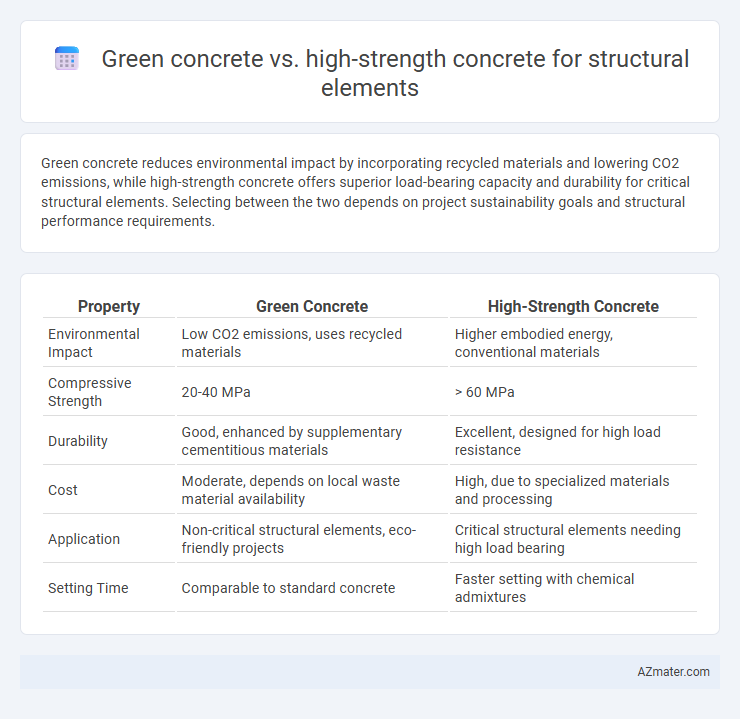Green concrete reduces environmental impact by incorporating recycled materials and lowering CO2 emissions, while high-strength concrete offers superior load-bearing capacity and durability for critical structural elements. Selecting between the two depends on project sustainability goals and structural performance requirements.
Table of Comparison
| Property | Green Concrete | High-Strength Concrete |
|---|---|---|
| Environmental Impact | Low CO2 emissions, uses recycled materials | Higher embodied energy, conventional materials |
| Compressive Strength | 20-40 MPa | > 60 MPa |
| Durability | Good, enhanced by supplementary cementitious materials | Excellent, designed for high load resistance |
| Cost | Moderate, depends on local waste material availability | High, due to specialized materials and processing |
| Application | Non-critical structural elements, eco-friendly projects | Critical structural elements needing high load bearing |
| Setting Time | Comparable to standard concrete | Faster setting with chemical admixtures |
Introduction to Green Concrete and High-Strength Concrete
Green concrete incorporates industrial by-products like fly ash and slag to reduce environmental impact while maintaining adequate strength for structural elements. High-strength concrete achieves compressive strengths typically above 6,000 psi through optimized mix designs and advanced materials, suitable for demanding load-bearing applications. Both types offer distinct benefits in sustainability and performance, depending on project requirements and environmental goals.
Key Material Components and Composition
Green concrete incorporates industrial byproducts like fly ash, slag, and recycled aggregates to reduce environmental impact while maintaining adequate strength and durability. High-strength concrete relies on low water-cement ratios, high-quality Portland cement, and chemical admixtures such as superplasticizers to achieve compressive strengths exceeding 6,000 psi. The distinct material composition in green concrete prioritizes sustainability, whereas high-strength concrete emphasizes optimized mix design for enhanced load-bearing capacity in structural elements.
Sustainability and Environmental Impact
Green concrete significantly reduces carbon emissions by incorporating recycled materials such as fly ash and slag, enhancing sustainability in structural elements. High-strength concrete emphasizes performance with a higher cement content, often leading to increased environmental impact due to greater CO2 production. Optimizing structural designs with green concrete balances durability and eco-friendliness, making it a preferred choice for reducing the carbon footprint of construction projects.
Mechanical Strength and Load-Bearing Capacity
Green concrete, incorporating recycled materials and industrial by-products, offers improved sustainability with mechanical strength comparable to conventional concrete but generally lower than high-strength concrete. High-strength concrete, characterized by compressive strengths exceeding 50 MPa, delivers superior load-bearing capacity and enhanced durability for critical structural elements such as beams and columns. Comparing mechanical properties, high-strength concrete provides better resistance to axial and flexural loads, while green concrete contributes to environmental benefits without significantly compromising structural performance.
Durability and Service Life Considerations
Green concrete, incorporating recycled materials and industrial by-products, offers enhanced durability through reduced permeability and increased resistance to chemical attacks, extending structural service life especially in aggressive environments. High-strength concrete exhibits superior mechanical properties and dense microstructure, providing exceptional compressive strength and improved resistance to cracking under high loads, which can lengthen the lifespan of critical structural elements. Selecting between green and high-strength concrete depends on the specific durability requirements, environmental exposure conditions, and sustainability goals of the construction project.
Workability and Construction Practices
Green concrete, incorporating recycled materials and industrial by-products, often exhibits enhanced workability due to finer particle sizes and improved water retention properties, which facilitate easier placement and compaction in structural elements. High-strength concrete, characterized by low water-cement ratios and high cement content, typically requires careful mix design and specialized curing techniques to maintain workability without compromising strength or causing early-age shrinkage. Construction practices for green concrete focus on environmental benefits and often adapt traditional methods to optimize setting times, while high-strength concrete demands precise handling and timely placement to avoid issues like cold joints or reduced durability in load-bearing structures.
Cost Analysis and Economic Viability
Green concrete often presents lower life-cycle costs due to the use of recycled materials and reduced environmental impact, leading to potential savings in waste disposal and regulatory compliance fees. High-strength concrete typically requires higher initial investment in specialized materials and production processes but offers longer-term economic benefits through enhanced durability and reduced maintenance costs. Evaluating structural elements, green concrete is economically viable for sustainable projects seeking cost-effective environmental solutions, whereas high-strength concrete suits applications demanding superior load-bearing capacity and longevity despite higher upfront expenses.
Applications in Structural Elements
Green concrete, known for its sustainability and reduced carbon footprint, is increasingly used in structural elements such as beams, columns, and slabs where environmental impact is a priority without compromising basic strength requirements. High-strength concrete, characterized by compressive strengths exceeding 6,000 psi, is ideal for critical structural elements that demand superior load-bearing capacity, like high-rise buildings, bridges, and heavy-load foundations. Selection between the two depends on specific project needs, balancing sustainability goals with performance demands in structural applications.
Challenges and Limitations
Green concrete faces challenges in achieving consistent quality due to variability in recycled materials and alternative binders, which can affect its long-term durability and strength in structural elements. High-strength concrete presents limitations in workability and increased risk of early-age cracking caused by higher cement content and heat generation during curing. Both types require careful mix design optimization and specialized curing techniques to balance performance requirements with environmental impact and structural safety.
Future Trends and Innovations
Green concrete integrates recycled materials and reduces carbon emissions, driving innovations in sustainable construction with enhanced durability and thermal insulation for structural elements. Future trends emphasize incorporating nanomaterials and bio-based additives to improve mechanical properties while minimizing environmental impact in green concrete formulations. High-strength concrete continues to evolve with advancements in fiber reinforcement and ultra-high-performance mixes, targeting applications demanding superior load-bearing capacity and durability in critical infrastructure projects.

Infographic: Green concrete vs High-strength concrete for Structural element
 azmater.com
azmater.com